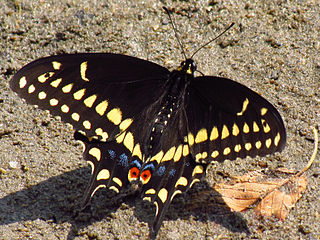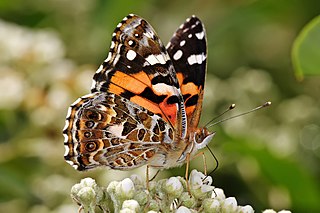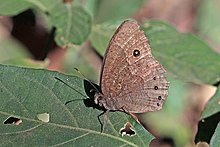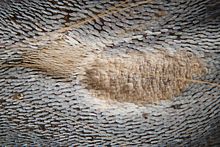
Butterflies are winged insects from the lepidopteran suborder Rhopalocera, characterized by large, often brightly coloured wings that often fold together when at rest, and a conspicuous, fluttering flight. The group comprises the superfamilies Hedyloidea and Papilionoidea. The oldest butterfly fossils have been dated to the Paleocene, about 56 million years ago, though they likely originated in the Late Cretaceous, about 101 million years ago.

Aglais io, the European peacock, or the peacock butterfly, is a colourful butterfly, found in Europe and temperate Asia as far east as Japan. It was formerly classified as the only member of the genus Inachis. It should not be confused or classified with the "American peacocks" in the genus Anartia; while belonging to the same family as the European peacock, Nymphalidae, the American peacocks are not close relatives of the Eurasian species. The peacock butterfly is resident in much of its range, often wintering in buildings or trees. It therefore often appears quite early in spring. The peacock butterfly has figured in research in which the role of eyespots as an anti-predator mechanism has been investigated. The peacock is expanding its range and is not known to be threatened.

Papilio polyxenes, the (eastern) black swallowtail, American swallowtail or parsnip swallowtail, is a butterfly found throughout much of North America. An extremely similar-appearing species, Papilio joanae, occurs in the Ozark Mountains region, but it appears to be closely related to Papilio machaon, rather than P. polyxenes. The species is named after the figure in Greek mythology, Polyxena, who was the youngest daughter of King Priam of Troy. Its caterpillar is called the parsley worm because the caterpillar feeds on parsley.

The speckled wood is a butterfly found in and on the borders of woodland areas throughout much of the Palearctic realm. The species is subdivided into multiple subspecies, including Pararge aegeria aegeria, Pararge aegeria tircis, Pararge aegeria oblita, and Pararge aegeria insula. The color of this butterfly varies between subspecies. The existence of these subspecies is due to variation in morphology down a gradient corresponding to a geographic cline. The background of the wings ranges from brown to orange, and the spots are either pale yellow, white, cream, or a tawny orange. The speckled wood feeds on a variety of grass species. The males of this species exhibit two types of mate locating behaviors: territorial defense and patrolling. The proportion of males exhibiting these two strategies changes based on ecological conditions. The monandrous female must choose which type of male can help her reproduce successfully. Her decision is heavily influenced by environmental conditions.

Stabilizing selection is a type of natural selection in which the population mean stabilizes on a particular non-extreme trait value. This is thought to be the most common mechanism of action for natural selection because most traits do not appear to change drastically over time. Stabilizing selection commonly uses negative selection to select against extreme values of the character. Stabilizing selection is the opposite of disruptive selection. Instead of favoring individuals with extreme phenotypes, it favors the intermediate variants. Stabilizing selection tends to remove the more severe phenotypes, resulting in the reproductive success of the norm or average phenotypes. This means that most common phenotype in the population is selected for and continues to dominate in future generations.

The small heath is a butterfly species belonging to the family Nymphalidae, classified within the subfamily Satyrinae. It is the smallest butterfly in this subfamily. The small heath is diurnal and flies with a noticeable fluttering flight pattern near the ground. It rests with closed wings when not in flight. It is widespread in colonies throughout the grasslands of Eurasia and north-western Africa, preferring drier habitats than other Coenonympha, such as salt marshes, alpine meadows, wetlands, and grasslands near water. However, habitat loss caused by human activities has led to a decline in populations in some locations.

Polygonia c-album, the comma, is a food generalist (polyphagous) butterfly species belonging to the family Nymphalidae. The angular notches on the edges of the forewings are characteristic of the genus Polygonia, which is why species in the genus are commonly referred to as anglewing butterflies. Comma butterflies can be identified by their prominent orange and dark brown/black dorsal wings.

Boloria selene, known in Europe as the small pearl-bordered fritillary and in North America as the silver-bordered fritillary, is a species of butterfly of the family Nymphalidae. It is found across Europe, Asia and North America, and feeds exclusively on violets in its larval stages. This species prefers wet grassland habitats, where its larval food source, violets, are found. It overwinters in its larval stage, and eggs hatch in the late summer to early autumn. Members of this species are prey for multiple types of birds and other insects.

The grayling or rock grayling is a species in the brush-footed butterfly family Nymphalidae. Although found all over Europe, the grayling mostly inhabits coastal areas, with inland populations declining significantly in recent years. The grayling lives in dry and warm habitats with easy access to the sun, which helps them with body temperature regulation.

A polyphenic trait is a trait for which multiple, discrete phenotypes can arise from a single genotype as a result of differing environmental conditions. It is therefore a special case of phenotypic plasticity.

The queen butterfly is a North and South American butterfly in the family Nymphalidae with a wingspan of 80–85 mm. It is orange or brown with black wing borders and small white forewing spots on its dorsal wing surface, and reddish ventral wing surface fairly similar to the dorsal surface. The ventral hindwings have black veins and small white spots in a black border. The male has a black androconial scent patch on its dorsal hindwings. It can be found in meadows, fields, marshes, deserts, and at the edges of forests.

Papilio demodocus, the citrus swallowtail or Christmas butterfly, is a swallowtail butterfly which commonly occurs over the entirety of sub-Saharan Africa, including Madagascar, besides the southern Arabian Peninsula. The caterpillars feed on various native plants of especially the family Rutaceae, but have also taken to the leaves of cultivated citrus trees.

Mud-puddling, or simply puddling, is a behaviour most conspicuous in butterflies, but also occurring in other animals, primarily insects. The organism seeks out nutrients in certain moist substances such as rotting plant matter, mud and carrion, and suck up the fluid. Where the conditions are suitable, conspicuous insects such as butterflies commonly form aggregations on wet soil, dung or carrion. From the fluids they obtain salts and amino acids that play various roles in their physiology, ethology and ecology. This behaviour also has been seen in some other insects like the leafhoppers, e.g. the potato leafhopper, Empoasca fabae.

The Australian painted lady is a species of butterfly mostly confined to Australia, although westerly winds have dispersed it to islands east of Australia, including New Zealand. Debate surrounds the taxonomy of this species. Some believe that the Australian painted lady should be a subspecies of the painted lady due to the similarity in lifestyle and behaviour. Furthermore, the painted lady is found around the globe, but Australia is the only location in which it varies enough to be considered a separate species.

An eyespot is an eye-like marking. They are found in butterflies, reptiles, cats, birds and fish.

Scathophaga stercoraria, commonly known as the yellow dung fly or the golden dung fly, is one of the most familiar and abundant flies in many parts of the Northern Hemisphere. As its common name suggests, it is often found on the feces of large mammals, such as horses, cattle, sheep, deer, and wild boar, where it goes to breed. The distribution of S. stercoraria is likely influenced by human agriculture, especially in northern Europe and North America. The Scathophaga are integral in the animal kingdom due to their role in the natural decomposition of dung in fields. They are also very important in the scientific world due to their short life cycles and susceptibility to experimental manipulations; thus, they have contributed significant knowledge about animal behavior.

Oeneis chryxus, the chryxus Arctic or brown Arctic, is a butterfly of subfamily Satyrinae found in the far northwest regions of Canada and the United States. The brown Arctic has highly variable colorings, which tend toward light yellow to orange brown wings that help camouflage it against its mountainous rocky habitat. The larvae feed on local grasses and take two years to develop. This longer development period results in flights of adult brown Arctics only once every two years. The butterflies feed on nectar from various plants as their primary food source.
Bicyclus ena, the grizzled bush brown, is a butterfly of the family Nymphalidae. It is found from KwaZulu-Natal to Eswatini, Mpumalanga, from Zimbabwe to Kenya and in Uganda.

Nemoria arizonaria is a species of moth belonging to the family Geometridae. It was first described by Augustus Radcliffe Grote in 1883. It is indigenous to Arizona, New Mexico and the Davis Mountains in Texas.

Phaedon cochleariae is a non-social, holometabolous species of leaf beetle native to Europe.




























